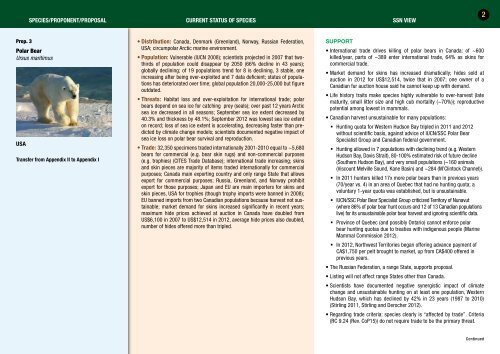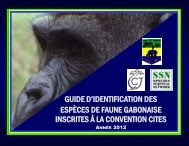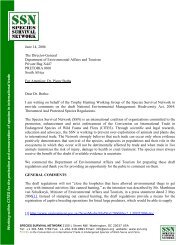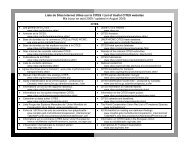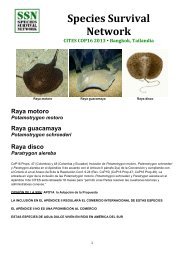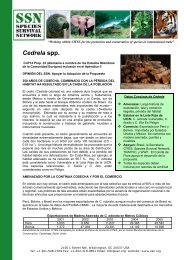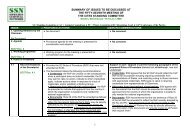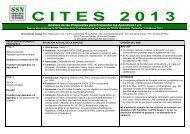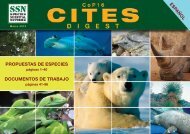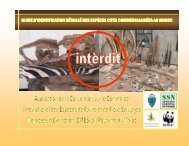CITES CoP16 Digest - Species Survival Network
CITES CoP16 Digest - Species Survival Network
CITES CoP16 Digest - Species Survival Network
Create successful ePaper yourself
Turn your PDF publications into a flip-book with our unique Google optimized e-Paper software.
SPECIES/PROPONENT/PROPOSAL CURRENT STATUS OF SPECIES SSN VIEW<br />
2<br />
Prop. 3<br />
Polar Bear<br />
Ursus maritimus<br />
USA<br />
Transfer from Appendix II to Appendix I<br />
• Distribution: Canada, Denmark (Greenland), Norway, Russian Federation,<br />
USA; circumpolar Arctic marine environment.<br />
• Population: Vulnerable (IUCN 2008); scientists projected in 2007 that twothirds<br />
of population could disappear by 2050 (66% decline in 43 years);<br />
globally declining; of 19 populations trend for 8 is declining, 3 stable, one<br />
increasing after being over-exploited and 7 data deficient; status of populations<br />
has deteriorated over time; global population 20,000-25,000 but figure<br />
outdated.<br />
• Threats: Habitat loss and over-exploitation for international trade; polar<br />
bears depend on sea ice for catching prey (seals); over past 12 years Arctic<br />
sea ice decreased in all seasons; September sea ice extent decreased by<br />
40.3% and thickness by 48.1%; September 2012 was lowest sea ice extent<br />
on record; loss of sea ice extent is accelerating, decreasing faster than predicted<br />
by climate change models; scientists documented negative impact of<br />
sea ice loss on polar bear survival and reproduction.<br />
• Trade: 32,350 specimens traded internationally 2001-2010 equal to ~5,680<br />
bears for commercial (e.g. bear skin rugs) and non-commercial purposes<br />
(e.g. trophies) (<strong>CITES</strong> Trade Database); international trade increasing; skins<br />
and skin pieces are majority of items traded internationally for commercial<br />
purposes; Canada main exporting country and only range State that allows<br />
export for commercial purposes; Russia, Greenland, and Norway prohibit<br />
export for those purposes; Japan and EU are main importers for skins and<br />
skin pieces, USA for trophies (though trophy imports were banned in 2008);<br />
EU banned imports from two Canadian populations because harvest not sustainable;<br />
market demand for skins increased significantly in recent years;<br />
maximum hide prices achieved at auction in Canada have doubled from<br />
US$6,100 in 2007 to US$12,514 in 2012, average hide prices also doubled,<br />
number of hides offered more than tripled.<br />
SUPPORT<br />
• International trade drives killing of polar bears in Canada: of ~600<br />
killed/year, parts of ~389 enter international trade, 64% as skins for<br />
commercial trade.<br />
• Market demand for skins has increased dramatically; hides sold at<br />
auction in 2012 for US$12,514, twice that in 2007; one owner of a<br />
Canadian fur auction house said he cannot keep up with demand.<br />
• Life history traits make species highly vulnerable to over-harvest (late<br />
maturity, small litter size and high cub mortality (~70%)); reproductive<br />
potential among lowest in mammals.<br />
• Canadian harvest unsustainable for many populations:<br />
• Hunting quota for Western Hudson Bay tripled in 2011 and 2012<br />
without scientific basis, against advice of IUCN/SSC Polar Bear<br />
Specialist Group and Canadian federal government.<br />
• Hunting allowed in 7 populations with declining trend (e.g. Western<br />
Hudson Bay, Davis Strait), 80-100% estimated risk of future decline<br />
(Southern Hudson Bay), and very small populations (~160 animals<br />
(Viscount Melville Sound, Kane Basin) and ~284 (M’Clintock Channel)).<br />
• In 2011 hunters killed 17x more polar bears than in previous years<br />
(70/year vs. 4) in an area of Quebec that had no hunting quota; a<br />
voluntary 1-year quota was established, but is unsustainable.<br />
• IUCN/SSC Polar Bear Specialist Group criticized Territory of Nunavut<br />
(where 86% of polar bear hunt occurs and 12 of 13 Canadian populations<br />
live) for its unsustainable polar bear harvest and ignoring scientific data.<br />
• Province of Quebec (and possibly Ontario) cannot enforce polar<br />
bear hunting quotas due to treaties with indigenous people (Marine<br />
Mammal Commission 2012).<br />
• In 2012, Northwest Territories began offering advance payment of<br />
CA$1,750 per pelt brought to market, up from CA$400 offered in<br />
previous years.<br />
• The Russian Federation, a range State, supports proposal.<br />
• Listing will not affect range States other than Canada.<br />
• Scientists have documented negative synergistic impact of climate<br />
change and unsustainable hunting on at least one population, Western<br />
Hudson Bay, which has declined by 42% in 23 years (1987 to 2010)<br />
(Stirling 2011, Stirling and Derocher 2012).<br />
• Regarding trade criteria: species clearly is “affected by trade”. Criteria<br />
(RC 9.24 (Rev. CoP15)) do not require trade to be the primary threat.<br />
Continued


